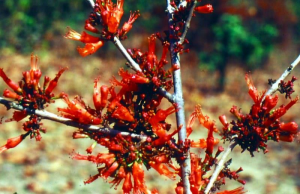Table of Contents
Dhataki
Woodfordia fruticosa Kurz – Ayurvedic Herb

Dhataki is mainly emphasized in the ancient ayurvedic texts as one of the most important Formentation products. Hence the names Madypujpa and Madakara.Caraka quoted it among the Fermenting egents (asava yoni). He also described Dhataki among the Purisasangrahaniya and Mutravirajaniya group of drugs.
Nighantu works highlighted its other properties like Garbhasthapaka (fertility agent), Atisara and pravahikakara (antidiarrheal), Visarpa (erycepales), Visa (poisoning) and pradara (menstrual disorders)
LITERARY REVIEW
- Charaka quoted it among the fermenting agents (Asava yoni).He aiso described Dhataki among the pureeshasangrahaniya and mutravirachaniya group of drugs.
- Susrutha charecterised it under Priyangvadi and Ambashtadi.
- Vagbahata charecterised it the same way as that of Susrutha.
- Nighantu works highlighted its other properties like garbhasthapaka(fertility),atisara and pravahikahara(antidiarrhoeal),visarpa(erysepales),visa(poisoning) andpradara(menstrual disorders).
SYNONYMNS
Dhataki-: The drug is useful in many diseases or the flowers are beautiful to look at.
Tamrapushpi-: Flowers are reddish brown or coppery coloured.
Vahnijwala-: During flowering season the flowers look like flame of fire.
Subhiksha-: There is no scarcity of drug or grows abundantly.
Madyavasini-: Flowers are used for fermentation of asava or arishta.
Bahupuspika-: Plenty of flowers on the plant.
Paarvatiya-: Prefers hilly region.
Madahetu-: causes fermentation.
Dhatupushpi-: Flowers are red in colour.
VERNACULAR NAMES
Hindi-: Dhaya
English-: Fire flame bush
Telugu-: Are puvvu
Tamil-: Dhatharijargi
Gujarathi-: Dhavadi
Bengali-: Dhai
Marathi-: Dhalas
USEFUL PART
Flower
Bark
Leaves
CHEMICAL CONSTITUENT
Flowers- Hecogenin, inositol, kaemperol-3-,glucoside, naringenin-7-7 glucoside, tannins (pyrogallol and hydrolysable types ),woodfordins A,B and C, lawsone, botulin etc
PROPERTIES
Rasa -: kashaya, katu
Guna -: laghu, ruksha
Virya -: Sita
Vipaka -: Katu
Dosaghnatha -: Kapha-Pitta shamaka
KARMA
Sandhaniya, mutravirachaniya (according to charaka)
Raktapittasamaka, atisara (according to Rajaballabhanighantu)
Kushtaghna (Cha:Chi:7/95)
Jwaraghna (Bhangasena)
Vranaropana (according to Cha:Chi:25/66-67)
Garbhajanana (according to Gadanigraha 6/5-9)
Krimighna (according to Bhavaprakashanighantu)
USES
According to Dhanwantharinighantu,
- Atisara
- Garbhasthapani
- Krmi
- Raktasrava
- Madakarana
- Vishanashini
According to Raja nighantu,
- Madakarana
- Vishanashini
- Visarpa
- Vrananashini
According to Bhavaprakaskha,
- Trishna
- Atisara
- Pittasra
- Visa
- Krmi
- Visarpa
According to Rajavahana,
- Raktapitta
- Atisara
According to madhavadravyagunanighantu
- Raktarshahsravanasini
According to Bangasena
- Jwara, atisara
THERAPEUTIC USAGE
- Svedapradara – Dhataki powder shall be given with honey.
- Prajasthapana- Nilotpala and dhataki are mixed and taken with honey in the morning during Rtukala (period of Ovulation).
- Pittabhishyanda- The powder or juice of dhataki and chandana are mixed with breast milk and applied as anjana.
RESEARCH AND STUDY
1) Oenothein B exhibiled remarkable host mediated antitumor activity; Woodfordin C also showed anti tumor activity.
(Chem.Pharm.Bull. 1990,38,1211).
2) Woodfordin C showed inhibitory activity towards DNA topoisomerase II .
(Chem.Pharm.Bull.1990,38,2687)
3) Woodfordin D and Ocnothein A exhibited significant host mediated anti tumor activity.
(Chem.Pharm.Bull.1991,39,1157).
4) Extract of flowers possessed significantabortifacient activity in mice.
(Ind.J.Med.Res,1975,63,378)
5) The antipyretic activity of flower is studied in albino rats.
(Alam.et al;1986).
6) Significant immune modulatory activity of W.Fruiticosa flowers is reported.
(Kores et al;1993).
MATHRA
Powder – 1-5 g
PushpaChurna – 3-6g
YOGAS
According to BhaishajyaRatnavali
- Kutajarishta – Rakthasthambana, Dipana, Grahani
- Pippaliyaasava – Grahani, Yakritbalya, Dipana, Pachana
- Kanakasava – Kasasvasahara, Shoolahara, Kaphasrava,
Peshisankojahara
- Abhayarishta – Dipana, Pachana
- Ashokarishta – Grahani, Dipana, Raktasthambhana,
Varnaprasadhana
- Paarthyadyarishta – Raktaprasadana, Balya, Medhohara
According to Astangahridaya
- Abhayarishta – Dipana, Pachana
